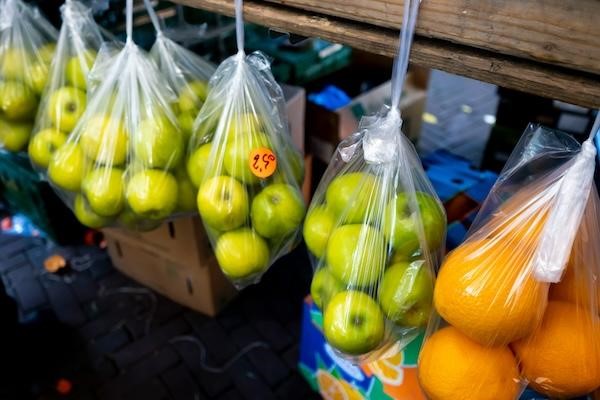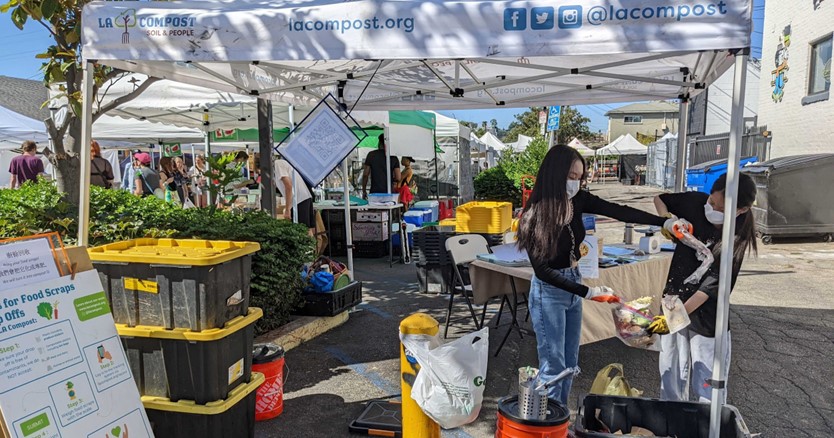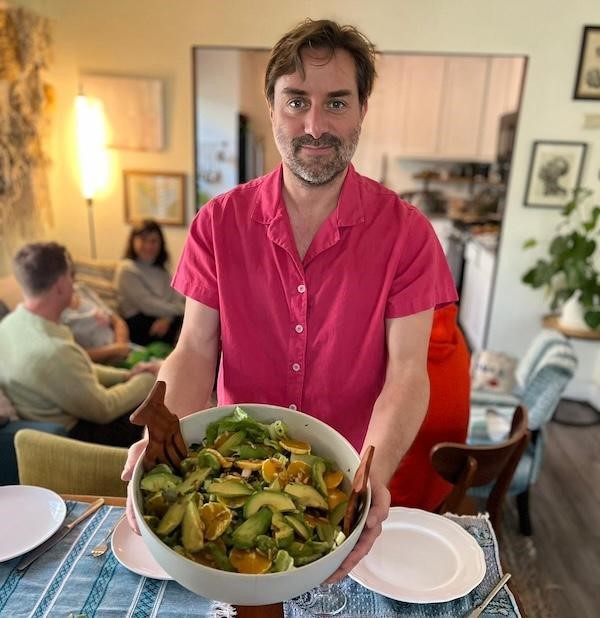
by SCLA | Mar 29, 2024 | Explainers
By Sarah Lawton
Every time you finish unpacking groceries in Los Angeles, do you give your recycling bin a little pat on the lid? It’s a routine for many Californians – toss the plastic produce bags in, flatten the to-go container, and feel good about doing your bit for the environment.
But hold on a minute – are you sure everything you’re tossing in there is actually recyclable? Turns out, navigating LA’s recycling rules can be trickier than assembling furniture from IKEA. And to make matters worse, LA Sanitation keeps changing the rules, leaving us scratching our heads about what goes where.
Lately, they’ve tightened things up even more. Now, only plastics labeled with codes 1, 2, and 5 get the green light for recycling. All other plastics? Straight to the trash. It’s enough to make your head spin. So, here’s a quick guide from LA Sanitation & Environment (LASAN), and a summary of what the codes mean:
- Code 1 (PET Plastics): Think soda bottles and peanut butter jars.
- Code 2 (HDPE Plastics): Milk jugs and shampoo bottles are a go.
- Code 5 (Polypropylene Plastics): Deli soup containers and yogurt tubs – recycle away!
Clean paper, metal cans, and glass bottles are all fair game for the recycling bin too. But that greasy pizza box? That’s where the compost bin comes in. Since 2023, it’s been mandatory for all of us Angelenos to have one. Don’t comply? Prepare for a fine.
Coffee grounds, eggshells, and even those napkins with a bit of sauce on them – all perfect for composting. But here’s the kicker: those “compostable” utensils? Not so much. Despite the label, they go in the trash because they need special conditions to break down properly. And those flimsy plastic bags from the grocery store? Toss ‘em in the trash. They don’t have the necessary properties for easy recycling either.
As we tackle the ins and outs of waste management, let’s keep striving for greener solutions.
Need a quick guide to help you sort it all out? Check out this guide from LA Sanitation & Environment (LASAN).
Now go ahead, give your recycling bin a hug – just make sure it’s filled with the right stuff.

by SCLA | Mar 29, 2024 | Explainers
Guest article by Elena Lopez, Outreach and Communications Manager for LA Compost
LA Compost was born in 2013 from the passion and collaboration of volunteers, friends, and families, driven by a shared desire to raise awareness about the environmental impact of organic waste. Initially, our dedicated collection crew pedaled through the streets with bike trailers, ferrying food scraps, leaves, paper, and other organic materials from various establishments to local compost centers. While successful in other cities, this approach proved challenging to sustain in the vast expanse of Los Angeles.
In 2014, LA Compost pivoted towards a decentralized model centered on community compost hubs, nurtured and cherished by engaged local residents. These hubs sprouted in churches, schools, gardens, and workplaces, weaving into the fabric of neighborhoods across LA County. Each hub is a unique reflection of its community, yet all share the common goal of composting locally while fostering connections among people and nature.
In 2018, we aligned our initiatives with the Hierarchy to Reduce Food Waste and Grow Community, as outlined by the Institute for Local Self-Reliance. Our programs cater to individuals through home composting, and empower communities with education and access to a decentralized composting network, including our Farmers’ Market Food-Scrap Drop-off program.
Reflecting on a decade of composting efforts alongside communities throughout Los Angeles in 2023, we draw inspiration from the boundless creativity of each engaged community. What began modestly as bike-powered collections and backyard composting among friends and family has evolved into a robust network of drop-off locations, processing hubs in parks, and educational initiatives citywide.
The rollout of the City of Los Angeles’ Organics LA program in 2023 marked a significant milestone, enabling 750,000 single-family homes to participate in curbside organics collection, in compliance with the statewide mandate SB 1383. We eagerly collaborate with the city to surpass these requirements.
Looking ahead, our vision encompasses expanding Farmers’ Market Food-Scrap Drop-off locations, fortifying existing Compost Hubs, launching new Park Hubs for localized processing, enhancing Compost Coaching opportunities, and introducing the “Magic Soil Bus” to educate K-12 students about composting.
As we celebrate a decade of progress, we acknowledge that our achievements are fueled by the collective efforts of partners and supporters—our “human network.” Just as mycelium nourishes the soil, our community members nurture thriving ecosystems across LA. As advocates for the Sierra Club, we trust in your commitment to preserving vibrant communities and ecosystems for all beings. You can get involved by finding a composting option near yousigning up to volunteer, or making a donation to support our mission.
Thank you, and we look forward to welcoming you to a compost pile soon.

by SCLA | Mar 29, 2024 | Explainers
By Joan Schipper
Buying fresh, locally sourced produce in just the amount you need reduces food and packaging waste. Your nearby Certified Farmers Market (CFM) is a great place to start. From the Los Angeles County Certified Farmers Markets website:
About Farmers Markets. The term “certified” used in the phrase “Certified Farmers’ Markets” means that the produce is brought to the market straight from the farm, either by the farmer personally, a family member, or by an employee. Only California grown produce may be certified.
Not all outdoor markets are CFMs. Some are for-profit ventures, organized to bring produce from the wholesale produce market downtown. Many of the same CFM advantages will apply, but the goods will not come straight from the farm.
Shopping a CFM means that, without the middleman, more of your grocery dollars go into the farmers’ pockets. To be sure, you will find less variety without imported goods (like Chilean peaches in December). But your seasonal fruits and vegetables will be fresher and unlikely to be treated for preservation or cosmetics.
At a CFM, you can choose just as much as you want from organic and sustainable produce offerings, and pack it in your own reusable bags. You might also find local bread, eggs, meats, flowers, and plants. One of my favorite farmers brings olive oil, olives, and vinegars. For shopping-day convenience, most markets host a variety of ready-to-eat foods or prepared ingredients.
An unexpected benefit of shopping at the smaller neighborhood farmers market is the social aspect. You’ll meet neighbors, as well as farmers’ representatives, and maybe trade produce-selection advice, menu ideas, recipes, and cooking techniques. Many markets feature a roster of local musicians; bring your pals and stop for coffee and a croissant, or a tamale, after shopping.
So, how do you get started shopping locally? The best way to get started is to check the LA County Certified Farmers Markets Website, where you can search by location or browse by community name.
It may take some time to find your favorite market and, if you are lucky, there will be a number of them within your personal “shopping zone.” Explore a few and figure out whether you like a small, nearby market or a large, varied market. Are you interested in the prepared food and other merchandise offered at large markets? Are the community programs (health expos, pie- or pickle-making contests, agency fairs) engaging? Do the kids love a petting zoo with alpacas, ducks, pot-belly pigs and bunnies?
When you arrive at a market, explore a little before you start buying. The vendors’ offerings will change from week to week as the seasons progress. Browse first to see who has the cucumbers, tomatoes, lettuce, or squash you prefer. You might find some deals like “soft” tomatoes or “ugly” pears.
Consider bringing paper, mesh, or used plastic bags for each kind of produce, and remember to bring your carry-all, tote, basket, or market cart to manage your purchases. You’ll be amazed at the variety of carts and wagons shoppers employ to haul their goods up and down the market. Happy and sustainable shopping!
_______________
Joan Schipper retired early on the Hiking-is-My-Retirement-Plan. On weekends, she leads hikes with the Central Group (Newcomers Hikes and White Cane hikes) but loves her weekday hikes with friends in the San Gabriel Mountains. The only thing she values more than hiking is camping.

by Mathieu Bonin | Mar 29, 2024 | Explainers
 Michelle Davis is the recipe creator of Bad Manners. Michelle has published several books, among them Bad Manners: The Official Cookbook (#1 New York Times best seller) and Hungry as Hell (October 2023). With Matthew Holloway (photographer), she animates, with great sense of humor, an Instagram account and a wonderful website where you can find mouthwatering recipes via a user-friendly search engine. Basmati Stuffed Grilled pepper is already on my menu! Finally, you can also follow Michelle Davis with her new weekly newsletter called Stir the Pot and be part of a community on Substack.
Michelle Davis is the recipe creator of Bad Manners. Michelle has published several books, among them Bad Manners: The Official Cookbook (#1 New York Times best seller) and Hungry as Hell (October 2023). With Matthew Holloway (photographer), she animates, with great sense of humor, an Instagram account and a wonderful website where you can find mouthwatering recipes via a user-friendly search engine. Basmati Stuffed Grilled pepper is already on my menu! Finally, you can also follow Michelle Davis with her new weekly newsletter called Stir the Pot and be part of a community on Substack.
Michelle is dedicated to the art of crafting vegan recipes, using fresh and seasonal ingredients. However, for Michelle, the conversation about cooking goes far beyond the kitchen table, as you will see. Food is a good entry to reflect on today’s world. But the first word that comes to my mind after the interview is “kindness”. As Bad Manners says, “It’s OK to be soft”. Our conversation has been edited for length and clarity.
Can you tell us a little bit more about the philosophy behind your title “Bad Manners”?
I’m glad you picked up on that because the food that I cook is all vegan. I want to be conscious of the earth and my carbon footprint and all these things, but I don’t want it to be pretentious. When people hear about vegan food, they think it’s some snobby sort of thing. I wanted to counteract that with the swearing and the kind of goofy talk that I use in the recipe to make it more down to earth. You don’t have to be a different kind of person to care about what you eat and to care about the planet. You can be you, just somebody with a silly sense of humor and who doesn’t take themselves too seriously.
Maybe you could remind us of what vegan means?
Veganism means you just don’t consume any animal products. It’s like vegetarianism, except vegetarians still eat dairy products and eggs. It has kind of gotten popular in the last 20 to 30 years because of how deeply flawed our food system is. The dairy industry, in the United States in particular, same thing with the egg industry, is awful in the treatment of animals. A lot of people are taking that extra step and cutting that part out of their diet just based on animal welfare.
Was there an ethical decision behind cooking Vegan?
Growing up, my mom told me: “if you want a vegetarian dinner, you’re just going to have to cook for yourself.” That’s exactly how I started learning how to cook, because it was important enough to me. And so, when I left the house when I was 18, that’s when I became vegan. For me, it’s tied to my love of animals. It is not necessary to participate in our deeply flawed food system and so I want to protest by opting out.
Could you elaborate on the process of self-education?
You become much more aware of what is in your food, whether it’s processed food or stuff someone makes for you. It’s one of the most liberating things you can do as a person, to learn how to cook whether vegan or otherwise, because you deepen your relationship with food, you understand what goes into it, and you really get to own your palate.
You aren’t dependent on these huge corporations to cook for you; corporations shouldn’t be cooking for you. People don’t understand what’s in their food anymore — we’ve become divorced from the preparation of our own food.
It also makes you more cost effective. It makes you a more informed eater, and it makes you more conscious of the seasons as well, as you are eating seasonally and locally. You recognize that a watermelon purchased in January is usually horrible.
Can you talk about how you link food and feminism?
There is a huge place for feminism in the kitchen, because it helps all of us recognize that domestic labor is labor. One of the most important things that we do for ourselves, or for our family, is create the food that we eat, and it becomes part of our body. The fact that cooking is devalued in the domestic sphere but overvalued as entertainment and culture (and it’s more of high culture when it’s famous male chefs) reveals a disparity that must shrink. It is disingenuous for us to value it so much as entertainment, and then give it no value in our own home. We need to start recognizing cooking as labor and as a form of art. There is art in our Grandmother’s chicken soup.
Is it relevant to talk about queer cooking the same way today we talk about queer ecology?
I think it makes sense. I think in the conversation of cooking and food being a kind of art, wherever there is that kind of mode of self-expression, you find queer people. They have been in our kitchens, in our restaurants, doing all this forever. I think as we start to more deeply understand the queer identity just outside of gay and lesbian, and all the space in between, we’ll see how many more people, both historically and present-day, fall into this idea of a queer ecology around food. Globalization has shrunk our world; our food is reflecting that, but queer people straddle so many identities, right? The more perspectives we bring in the kitchen, the better.
Food is an enormous source of waste and inequity. What education about food and cooking do we need, to make it more sustainable?
The first thing we need to realize is that we currently produce enough food on the planet to feed everyone. The issue is distribution. When we have abundance at our market, that means someone else doesn’t. As wonderful as it is to have so many things at our fingertips, especially when it comes to fresh produce, we need things more equally distributed across the country.
For people at home, they can do their part to reduce food waste by buying seasonally. So you’re not getting strawberries that were flown in from Ecuador because that’s not good for the planet, and they’re not going to taste that good. Eating seasonally is a great way to reduce waste and to reduce your carbon footprint.
Cooking at home is another great way, because you’re not going to get lentils with all this giant packaging, right? That’s another way to reduce waste—buying things in bulk and purchasing ingredients, instead of purchasing pre-packaged foods, as they often come highly processed. Shop realistically too. For example, frozen ingredients have gotten so much better. I’m not saying go buy frozen lasagna, but do buy frozen corn or frozen fruit.
What is your “star” produce right now?
The carrots are delicious right now. They’re very, very sweet. And here in California, we get wonderful artichokes in March, and there is nothing better. And to bring spring a little faster, I like to parboil or steam them and then finish them on the grill. I serve them with a little dipping sauce. You can make some braised carrots on the side with, like, an herb salad, which would be super, super delicious and bright. You can see the hopefulness for the warming days ahead.
______________________________
When Mathieu Bonin isn’t teaching philosophy at the French School, he volunteers with the Central Group, leading Trash Talk Saturdays and being its Conservation Chair.
[header image: Mathieu Bonin, California Citrus & Almond Salad – recipe here ]





 Michelle Davis is the recipe creator of Bad Manners. Michelle has published several books, among them Bad Manners: The Official Cookbook (#1 New York Times best seller) and Hungry as Hell (October 2023). With Matthew Holloway (photographer), she animates, with great sense of humor, an Instagram account and a wonderful website where you can find mouthwatering recipes via a user-friendly search engine. Basmati Stuffed Grilled pepper is already on my menu! Finally, you can also follow Michelle Davis with her new weekly newsletter called Stir the Pot and be part of a community on Substack.
Michelle Davis is the recipe creator of Bad Manners. Michelle has published several books, among them Bad Manners: The Official Cookbook (#1 New York Times best seller) and Hungry as Hell (October 2023). With Matthew Holloway (photographer), she animates, with great sense of humor, an Instagram account and a wonderful website where you can find mouthwatering recipes via a user-friendly search engine. Basmati Stuffed Grilled pepper is already on my menu! Finally, you can also follow Michelle Davis with her new weekly newsletter called Stir the Pot and be part of a community on Substack.